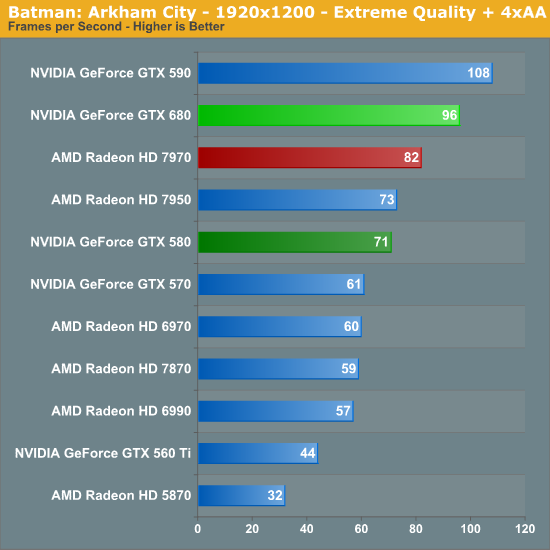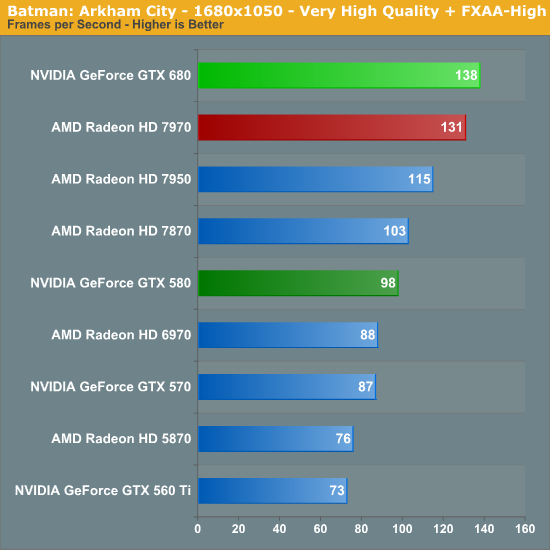NVIDIA GeForce GTX 680 Review: Retaking The Performance Crown
by Ryan Smith on March 22, 2012 9:00 AM ESTBatman: Arkham City
Batman: Arkham City is loosely based on Unreal Engine 3, while the DirectX 11 functionality was apparently developed in-house. With the addition of these features Batman is far more a GPU demanding game than its predecessor was, particularly with tessellation cranked up to high.



Once again the GTX 680 takes a respectable lead over the 7970, this time beating AMD’s top card by 13% at 2560, and coming very close to cracking 60fps here. The performance gains over the GTX 580 are also solid, with the GTX 680 leading by 34% or better.










404 Comments
View All Comments
chizow - Thursday, March 22, 2012 - link
Nvidia let AMD off the hook by productizing a mid-range GK104 ASIC as their flagship SKU and pricing it at $500.Its a great part no doubt and beats AMD in every metric, but as the article stated, its still going to be the smallest increase in price:performance that we've seen since 9800GTX.
Overall 28nm has been a huge disappointment so far in terms of performance increase over previous generations at the same price points, I guess we will have to wait for 28nm BigK to get that true high-end increase you'd expect from a smaller process node and new GPU arch.
B-Unit1701 - Thursday, March 22, 2012 - link
'Off the hook'? LMAO they released what they had. They are already months late, the only other option would have been to just not release a card this generation, would THAT have made you happier?chizow - Thursday, March 22, 2012 - link
No, what would have made me happier from both Nvidia and AMD would be to follow their own historical price:performance metrics.Instead, we have AMD first trying to pass an overall unimpressive Tahiti part as a high-end flagship at $550+ followed by Nvidia following suit by pricing their mid-range ASIC as a $500 part.
28nm has been a big disappointment so far, as we have the smallest increase in price:performance in any generation or process shrink since the 9800GTX.
CeriseCogburn - Thursday, March 22, 2012 - link
With AMD GF foundry failures TSMC is stoked to the gills. We're not going to get the prices you want for performance for another 6 months or so when production is freed up with TSMC's ongoing 2B expansion.You ought to include real inflation as well which is as we all know far higher than the socialist government figures that are suppressed so their automatic payout increases are lessened.
Be disappointed, a valid point, there are extenuating factors.
xrror - Thursday, March 22, 2012 - link
exactly. I completely understand why Nvidia is charging $500 for their mid-range part, but it still sucks.AMD also... I get why the 6000 series was gimped (it was originally supposed to be 32nm, and that fell through) but 7000 series... maybe that can be explained by moving to a new arch with GCN.
Regardless... disappointing. Well actually it's dissapointing that you must pay $500+ to get a card that /might/ give you a fresh gaming experience over the $350 card you bought last generation.
Unless AMD can pull a 8000 gen card out of their arse with drivers that work (i'm not optimistic) then you can bet if/when "full Kepler" comes out it will be $800+
CeriseCogburn - Friday, March 23, 2012 - link
Charlie D with his $299 leak, the only source, has made everyone think the 1core top card in the world was going to be released $150 cheaper than the current top 1core card in the world.He must still be laughing hard at semi-accurate.
chizow - Friday, March 23, 2012 - link
It wasn't Charlie's leak, it was the combined evidence of ~300mm^2 size, transistor count, mid-range specs, ASIC designation, and leaked GTX 670Ti pics also leading people to the conclusion this part was originally meant to be priced in that $250-$350 range.Obviously GK104 performed better than expected, coupled with Tahiti being weaker than expected, resulting in what we see today: an exceptionally performing mid-range ASIC being SKU'd as an overpriced flagship part at premium pricing.
CeriseCogburn - Tuesday, March 27, 2012 - link
Sorry I don't buy any of it. It's a "new architecture", if we take Charlie's leak, everything fits but the price, and every price has been $499 going on 4X in a row at least.chizow - Friday, March 23, 2012 - link
I agree, but honestly I don't even think AMD can compete at this point. Nvidia has beaten AMD at its own game soundly (small die, power efficient strategy, and done it with their 2nd best ASIC.Now they're free to make the slightly faster, power-hungry GPGPU monster GPU with as much TDP as they like without having to hear about it being worst than AMD's tree-hugging specs.
Sabresiberian - Friday, March 23, 2012 - link
Nvidia releasing their new architecture a few months after AMD released theirs does not make them late. Nvidia's schedule hasn't been the same as AMD's for several years now.And, what's AMD's answer to Big Kepler going to be? They lost today to Nvidia's mid-line chip, they will lose big time when Big Kepler comes out. By the time they catch up, Maxwell will be breathing down their necks.
;)